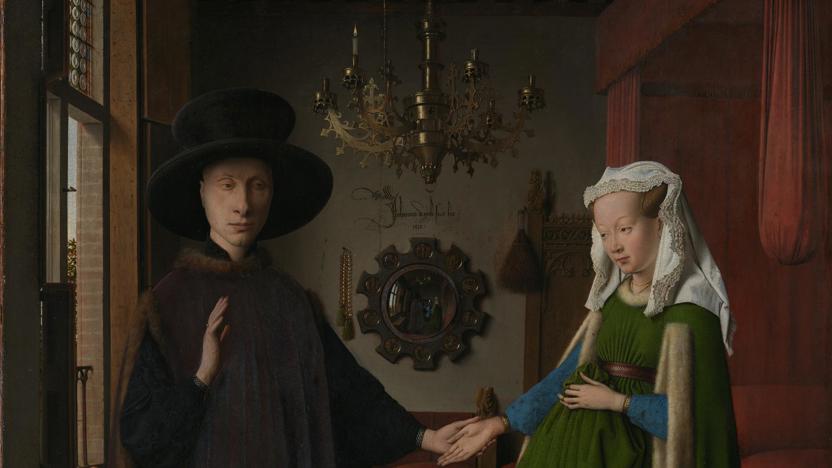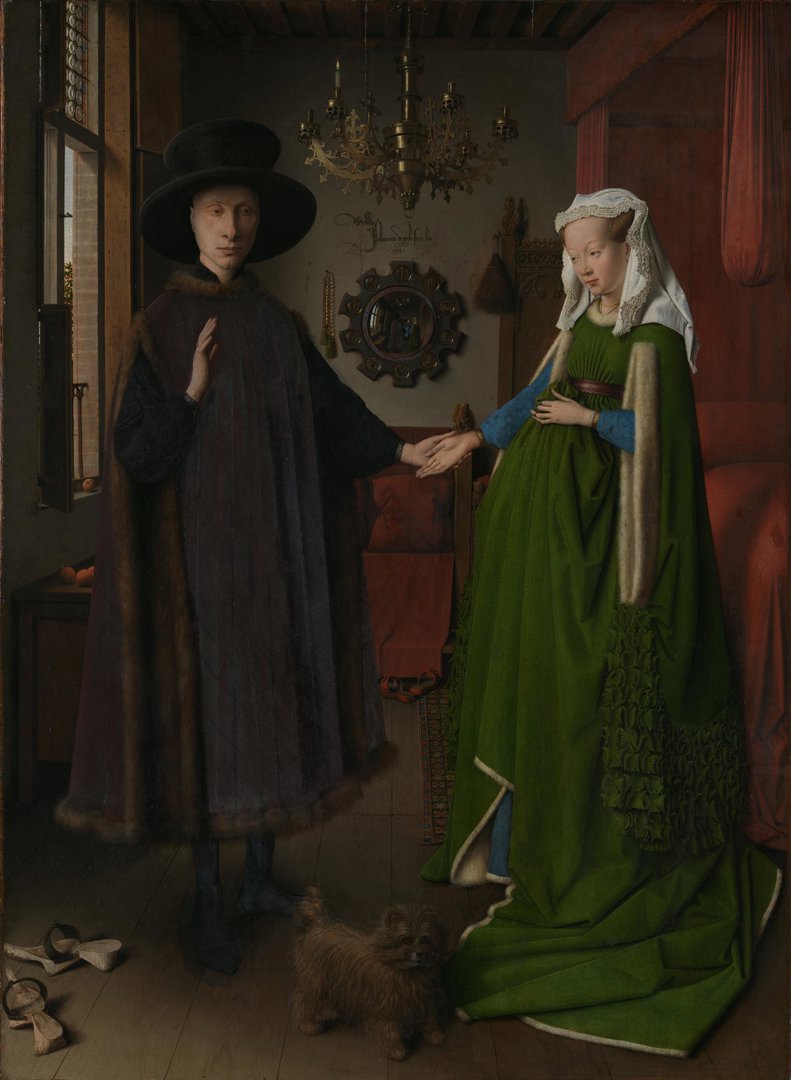Jan van Eyck's 'The Arnolfini Portrait'
Audio description
This is a description of 'The Arnolfini Portrait', by Jan van Eyck, painted in 1434. It is 82 centimetres high by 60 centimetres wide, painted in oils onto an oak panel, with a dark brown frame. Featuring astonishing detail, it was one of the earliest paintings in Western Europe to show off the ability of oil paint to create realistic depictions of objects and people.
The scene shows two people, a man and a woman, standing in a dimly lit room. Daylight enters through a window on the left, illuminating their elegant clothes, as well as items of furniture: a small chest under the window; the edge of a sumptuous bed covered in red cloth to the right; an ornate brass chandelier above the couple, and a striking convex mirror on the wall between them.
The man on the left faces us, his heavy-lidded eyes looking slightly down and to the right. His right hand is raised in front of him, as if in greeting. He wears a large, round, wide brimmed black hat, made of plaited straw, and a dark purple tabard with a brown fur trim. On his feet are slim, dark blue slippers - his discarded wooden overshoes lie on the floor to the left, splattered with mud. They are made of a lighter coloured wood than the darker floor boards.
The man holds out his left palm, on which the woman has laid her hand, also palm up. She is turned towards him, her head bowed. She wears an elaborate green overdress with long sleeves trimmed with white fur, a blue underdress visible only on her forearms. There is so much fabric it pools on the floor and she has gathered some of it up in front of her, holding it against her stomach with her free hand – this has led people to wonder if she might be pregnant, but the bulge is an excess of material, fashionable at the time.
Her light brown hair is gathered into equally fashionable horns either side of her head and covered with an intricately folded off-white veil. Between the couple, close to the floor, is a small brown dog, staring out at us, bright-eyed. Dogs would be a common sign of faithfulness in marriage, and every hair of its fur has been delicately rendered in oil paint.
The man is believed to be the wealthy Italian merchant, Giovanni Arnolfini, pictured in the reception room of his house in Bruges with, possibly, his second wife. The items around the room display his wealth, particularly the enormous bed which was kept in rooms to receive guests. Through the window on the left is a cherry tree
bearing fruit. There is an orange on the windowsill and more oranges on the chest beneath, at the time an expensive fruit.
The ornate brass chandelier above the couple, reflects the light from the window with astonishing clarity. It holds one lit candle and one that has been snuffed out. On the wall beneath between the couple, are the words, “Jan van Eyck was here. 1434” written in Latin, in elaborate, curling script.
Below the inscription, slightly to the left, hangs a string of orange-yellow amber prayer beads, suspended by a nail in the wall. At each end of the string, are delicate green silk tassels. The window’s light is caught on the top left of each bead in a tiny dot, but it also passes through, illuminating the lower right-hand side of each one, in delicate yellow crescents. Van Eyck has even painted reflections of the beads on the wall where they hang.
To the right of the beads is the convex mirror, with ten, short, blunt-ended spokes protruding from its frame. Each spoke contains a tiny disc, a roundel which holds a tiny painted scene from the Passion of Christ. The mirror reflects the room, the image curving on its surface. The backs of the man and the woman are clear, but between them lies the door into the room, which is our view point. Two figures, one in red and one in blue, are in the doorway, barely visible. Perhaps they are visitors, or the artist and his assistant – or perhaps they might even be us, welcomed into this 15th century home by Arnolfini and his wife.


